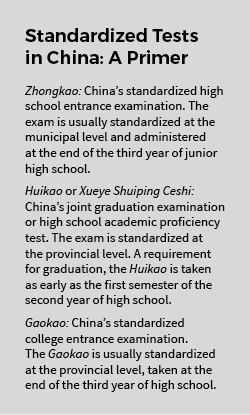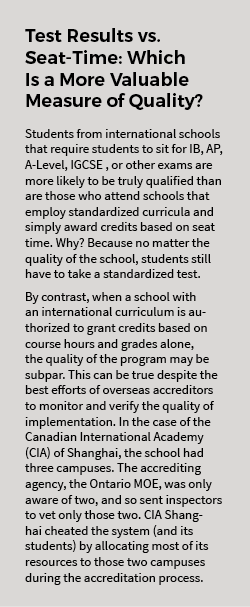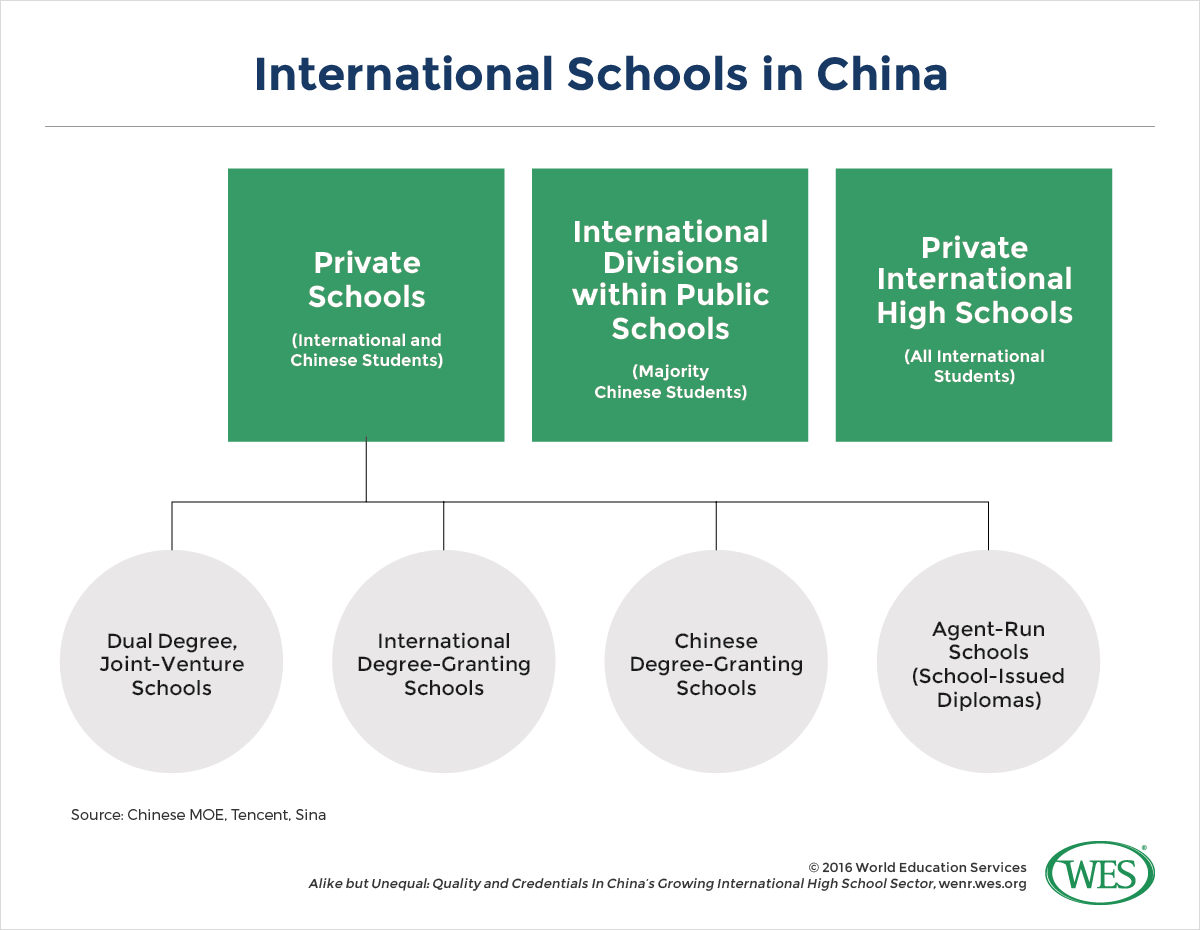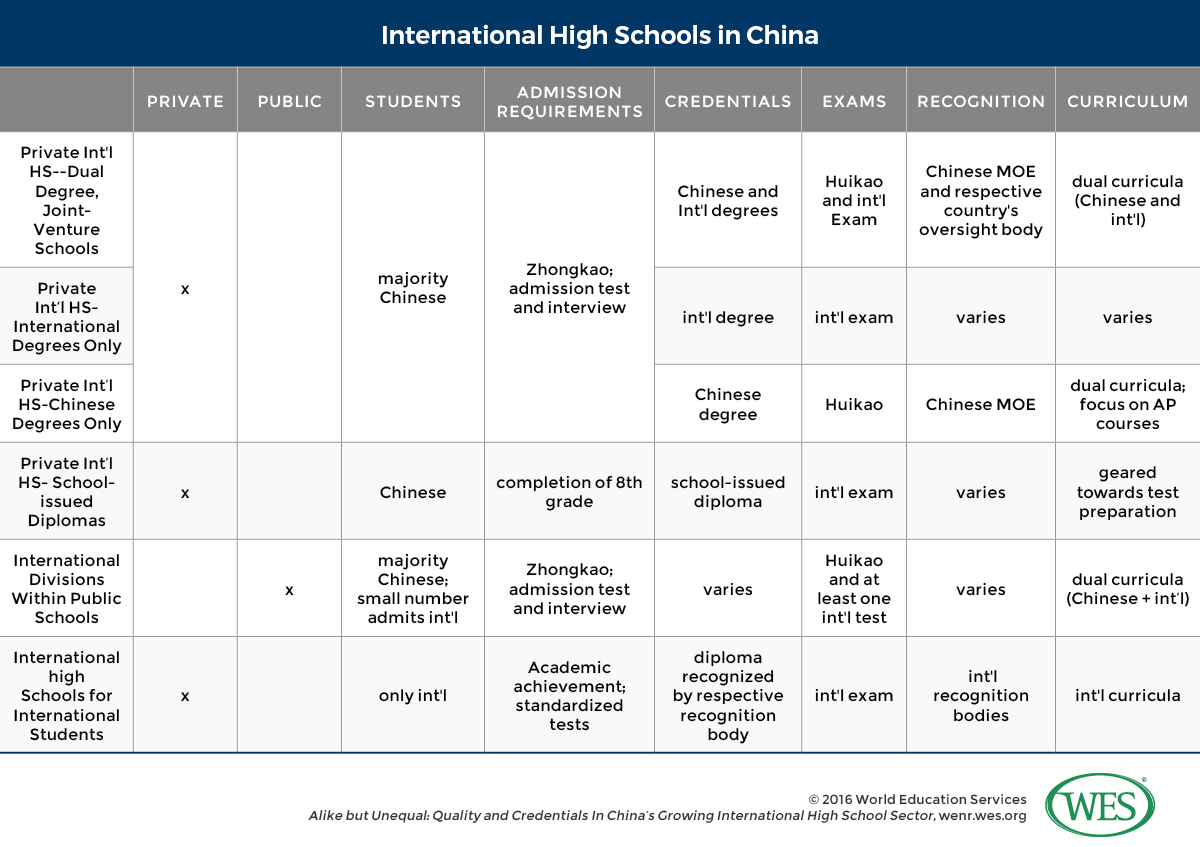Claire Mengshi Zheng, Credential Analyst and Jing Guan, Quality Assurance Specialist, WES
The 2014/2015 school year marked a shift in the mix of Chinese students on U.S. college campuses: It was the first time that undergraduate enrollments outstripped those of graduate students. These 124,552 students’ collective impact on campuses [2] is enormous. Some arrive fresh from U.S.-based high schools [3]. They’re already acclimatized to American culture and academic norms. But a significant number – many thousands [4] – are educated at international high schools throughout China.
The quality of this secondary schooling is directly relevant to Chinese undergraduates’ experience and success on U.S. campuses. Some schools offer rigorous college preparatory programs, including excellent training in English language skills and well-established international curricula. Others are essentially feeder schools aimed at supplying a hungry global market with the numbers it craves. As the number of international schools operating in China expands, it’s critical that international enrollment and recruitment personnel have deeper insight into the types now operating in China. Knowing how each type of school operates, how each prepares students for international education, and what types of credentials each provides can help institutions ensure 1) the long-term sustainability of internationalization initiatives, and 2) the preparedness and success of students who are admitted.
International High Schools in China: From Exceptional Quality to Fly-by-Night
At the broadest level, international schools in China can be categorized into three types:
- Privately operated schools for both international and Chinese students
- Public schools with international divisions
- Schools for international students only
The value of the credentials and the quality of education conferred by schools within these three types vary considerably. Some offer easily verifiable dual high school credentials, from China and the U.S., for example, or from China and the U.K. Some offer degrees recognized only by education authorities outside of China. Still others offer diplomas recognized only by the school itself; their pitch to families, not always true, is that they will prepare students to succeed on standardized exams required by U.S. institutions. Some schools are of exceptional quality; others are fly-by-night – run by shady operators who sell credits that help students get a coveted seat at institutions in the U.S., but then leave them unprepared to succeed.
The remainder of this article looks at three main international school types in China, and at some variations within each.
Private International High Schools for International and Chinese Students
One subset of international high schools includes privately run schools that admit both international and Chinese students. The majority of the schools offer programs that are internationally recognized – for instance, the International Baccalaureate Diploma Program [7] (IB), the AP Program [8], the International General Certificate of Secondary Education [9] (IGCSE), the GCE A Level [10], and others. Schools in this category may set their own admissions criteria, and conduct their own admissions interviews and tests. The most reputable schools also require that students take the Zhongkao as part of their admissions packet. These majority of these schools accept students who finished junior high school (grade nine) regardless of their nationalities.
Within this category of schools, there are four sub-categories that can be broken down based on the qualifications they offer, and the agencies or organizations that provide oversight and recognition:
1. Dual degree, Joint-Venture Schools
One type of international school is run as a joint venture between a Chinese school and foreign operator, and recognized by both the Chinese Ministry of Education (MOE) and the relevant oversight body in another jurisdiction (for instance, in the U.K., the United States, or Canada). Admission is usually contingent on performance on China’s standardized high school entrance examination (Zhongkao).
Once enrolled, students pursue dual academic tracks and curricula – Chinese and international. To graduate, students must sit for two sets of exit exams, the Huikao and the international exam for which they’ve prepared. This might include the A.P., the SAT, or the GCE A-Level. Students at these schools earn both Chinese and foreign credentials. The Beijing Royal School [11] is an example of this type of school. It offers bilingual curricula and dual degrees. Its students sit for the Huikao as a graduation requirement, and, upon successful completion, obtain a high school diploma recognized by Beijing Municipal Department of Education. They also obtain a high school diploma from a U.S. accredited high school upon completion of required AP courses.
 [12]2. International Degrees Only
[12]2. International Degrees Only
Often seen as an alternative to boarding schools abroad, some international schools offer international diplomas only. The Cambridge International Exam Center in Shanghai Experimental School (SESCIE) [13] is one example. The school is a registered member of University and College Admission Service (UCAS), and offers courses aligned with the International General Certificate of Secondary Educatio [14]n (IGCSE). (The National Recognition Information Centre for the United Kingdom (NARIC) [15] recognizes the IGCSE as comparable to the standard U.K. GCSE.) To apply for the school, students must to meet a minimum Zhongkao score, and sit for individual interviews and tests.
The best of these schools offer a pathway to high quality higher education institutions abroad. In 2016, almost a quarter of SECIE students were accepted to University College London, Oxford University, and Imperial College London [16]. The worst of these schools, however, are not above selling credits to any willing bidder. One recent case is illustrative: In July 2016, the Canadian International Academy (CIA) of Shanghai [17], an Ontario-accredited institution in China, had its license revoked, after investigators confirmed that, among other violations, students could pay to retake tests and even alter their transcripts to reflect better grades.
3. Chinese Degrees Only
A third type of private international school admits both foreign and domestic students. These schools employ a dual curricula (for instance, Chinese and American), but grant only Chinese degrees. One such school, Shanghai Tianjiabing Middle School International Curriculum Center, was established in 2006. It offers both Chinese and U.S. curricula, focusing in particular on Advanced Placement courses. However, the school is not accredited with any of the regional accrediting agencies in the U.S. Its students will, if they pass the Huikao, graduate with a Chinese high school diploma and some A.P. credits, rather than with any kind of American credential. If they fail the Huikao, they receive only a school-recognized high school diploma
 [18]4. School-Issued Diplomas
[18]4. School-Issued Diplomas
A fourth breed of international school has begun proliferating wildly to fill the growing global demand for tertiary students from China. Most of these programs are for-profit businesses run by education consulting firms or agents (sometimes in collaboration with other schools, sometimes not) and are geared solely towards test preparation and helping students obtain admission to international schools by, in some cases, almost any means necessary. There are literally hundreds of these schools now in existence, and more appear all the time.
Between the demand from newly middle-class families seeking to ensure their students obtain the educational pedigrees that will help them advance, and the demand among Western institutions seeking greater numbers of full-tuition students, there appears to be little ceiling on the potential continued growth of this profit-driven sector. For institutions seeking to ensure that the students they admit are qualified, the increased prevalence of these schools is troubling – especially given the often-over-intrusive role [19] that Chinese agents often play in helping students’ apply to foreign higher education institutions (in some cases writing application essays or even providing fraudulent transcripts or test scores).
In terms of quality, schools in this sector operate in operate in a grey zone, beyond the purview of both the Ministry of Education and international accrediting agencies. They have no admission requirements beyond families’ willingness to pay, and their students have a range of qualifications coming in: Some enter as of 8th grade; some are high school graduates seeking additional test prep; and some have dropped out of high school and are seeking reentry into the educational mainstream. These schools typically offer an ad hoc curriculum, which may or may not conform to any internationally recognized standards, and which does not conform to the Ministry of Education’s standards. At least one school’s even guarantees results: If students fail to get admitted by a certain level of U.S. college, its website says it will issue a refund. Students at these schools earn school-issued diplomas or certificates of completion only.
NOTE: The World Education Services credential evaluation team, which processes tens of thousands of Chinese credentials annually, has also begun to note a rise in the number of school-issued credentials submitted by students from China-based international schools affiliated with unaccredited U.S. high schools. Credentials offered by these independent schools present another red-flag in terms of quality and credibility.
Behind the Growth: ‘Insatiable’ Demand + A Relaxed Regulatory Environment
As of 2016, the Industry Report [20] counted more than 1,000 international schools in China. Only 597 have official government recognition. The International School Consultancy, which tracks data on international English language schools at the K-12 level, expects growth to continue. It has called Chinese demand for these schools, most of which are private, “insatiable [21]” (as have others [22]). In 2014, McKinsey & Company estimated that the percentage of Chinese secondary schools that were private had risen from three percent in 2004 to 10 percent a decade later. Several factors have contributed to the growing number of international high schools in China, including the demands of a newly massive middle class [23] and recent policy reforms. In 2015, for instance, the twelfth National People’s Congress voted and passed amendments on Education Law [24] and Higher Education Law [25]. This amendment clears obstacles for private education institutions (Minban) legislatively, and signals the government’s commitment to promoting privately-run schools.
International Divisions Within Public Schools
Some Chinese public schools have established divisions that offer an international curriculum in addition to a Chinese one. Although a small number of international divisions admit international students only (for instance, the international division of Shanghai High School [26]), the majority cater to Chinese students seeking admission to higher education institutions in the U.S. or elsewhere.
NOTE: According to some reports [27], Chinese city governments are cracking down on these programs. Because the programs are run by overseas entities which charge substantial tuitions (of more than USD $15,000 sin some cases), but operate on public school campuses and receive state support, they have begun to raise concerns about equity and access.
Students who attend these schools are admitted based on their Zhongkao results. These schools follow a bilingual, bi-curricula format. To graduate, students must pass standardized exams including the Huikao, and at least one international test such as the A-Level, IGCSE, I.B., or A.P. The types of credentials offered by these schools are variable, depending on how the program is structured.
In one scenario, students graduate with dual diplomas – a Chinese government-issued high school diploma and an international one. For example, Chengdu Shude High School [28] is a tier-one public school in Chendu, Sichuan Province. Its international division is sanctioned by the Chengdu municipal department of education. If qualified, students who graduate from Shude can obtain not only a Chinese high school diploma, but also an Australian certificate of education, the credential granted to high school students who successfully complete high school level studies, in this case, at a school recognized by the Australian state of Victoria. (NOTE: The international division of Shude is run by an MOE recognized education consulting agency, Huaying Education Consulting Corporation. The MOE maintains a list of recognized agents, which can be viewed here [29]. Recognition is not an absolute guarantor of quality, but it does offer a baseline guide for establishing credibility.)
In another scenario, students graduate with a government-issued Chinese diploma and some internationally recognized education credits. For instance, the International Department of the Affiliated High School of South China Normal University [30], offers an extensive A.P. curriculum. Highly-regarded in China and the international sector, the school nonetheless awards graduates a Chinese diploma issued by the municipal district only. Students do graduate with A.P. credits, but not an American degree.
In a third scenario, students may graduate with a diploma issued by the high school only, even though their schools also offer government-issued degrees. This is the case at the International Department of the Affiliated High School of South China Normal University [31] (discussed above). The school admits many non-local students (known as Zexiao Sheng), who cannot sit for the Huikao unless they go back to their home towns, where the records required to sit for the exam are stored. Many can’t afford the time or money to return to their hometowns, so do not take the exam. As a result they obtain a diploma issued only both their high school and not the municipal department of education – despite having acquired the same rigorous training as their peers.
International High Schools for International Students
These private international high schools are the most traditional and recognizable of the breed. Only international students, including students from Hong Kong, Macau, and Taiwan, or students holding foreign permanent residencies, can enroll. This type of school is registered with and recognized by international recognition bodies such as the U.S.-based Western Association of Schools and Colleges (WASC), International Baccalaurreate (IB), Cambridge International Examinations (CIE) et al.
For example, the Shanghai American School [32] is fully recognized by WASC, and is member of a number of educational and professional organizations, including the College Board, Advanced Placement Program (AP), IB, The Council for Advancement and Support of Education (CASE), and Principals’ Training Center (PTC). Students can choose to take A.P. courses or I.B. Diploma courses. Admissions decisions at these schools are based on student’s English language proficiency and demonstrated academic achievement. Standardized tests, such as Secondary School Admission Test (SSAT) and Northwest Evaluation Association, Measures of Academic Progress (MAP) are used as part of the admission procedure. A majority of the faculty are licensed international teachers. The students will graduate with high school diploma recognized by WASC. They can apply for universities abroad with their high school diplomas or IB diplomas. The Ministry of Education maintains a list [33] of these schools.


